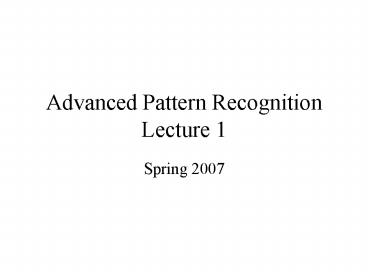Advanced Pattern Recognition Lecture 1 - PowerPoint PPT Presentation
1 / 27
Title:
Advanced Pattern Recognition Lecture 1
Description:
... for Pattern Analysis' Cambridge University ... Handwriting recognition on PDA. Structural PR: recognition of hanzi. ... Pattern Analysis Algorithm should be ... – PowerPoint PPT presentation
Number of Views:106
Avg rating:3.0/5.0
Title: Advanced Pattern Recognition Lecture 1
1
Advanced Pattern RecognitionLecture 1
- Spring 2007
2
- 1 J.Shawe-Taylor, N.Christianini,
- Kernel methods for Pattern Analysis
- Cambridge University Press, 2004.
- 2 B. Scholkopf, A.Smola,
- Learning with kernels, MIT Press, 2002.
- 3 www.kernel-methods.net
- 4 Journal papers, tutorials.
3
- Pattern Recognition is a field of Computational
Intelligence, where predefined form of an input
signal is searched or similarities between the
signal forms are studied. - The input signal can be from an electric
measurement or e.g. text documents. - Computational Intelligence includes methods
groups like Artificial Intelligence, Pattern
Recognition, Fuzzy Logic, Genetic Algorithms,
Neural Networks, etc. - Application fields include Image Analysis,
Speech Recognition, medical signal and DNA
sequence analysis.
4
Watanabe
5
- Traditionally Pattern Recognition (PR) is
divided into statistical pattern recognition and
structural pattern recognition. - In statistical PR signal statistics are needed
for recognition. - In structural (syntactical) PR a pattern is
described by a grammar for structural elements.
6
PR applications
7
PR applications (contd)
8
- Examples
- Handwriting recognition on PDA.
- Structural PR recognition of hanzi.
- Cluster analysis (area, length, etc.).
- How many clusters?
- Forest photo segmentation.
9
- Example Face detection
10
Example Segmentation for multiple sclerosis
11
(No Transcript)
12
- Salmon or Sea bass?
13
- Overfitting problem.
14
- Non-linear decision boundary
15
- Planetary data
3
T is period of convolution (years), and R is
radius of orbit The quantity R3/T2 remains the
same.
16
- Example Planetary data (1)
log(T)
or
log(R)
17
Example Planetary data (2)
y2/b2
y
x
x2/a2
The artificial planetary data lying on an ellipse
in two dimensions and the same data represented
using features x2 and y2 showing a linear
relation
18
- We will define pattern recognition as a function
(pattern function) for which - f(x) 0 (1)
- For example, for the planetary data
- f(R,T) R3?T20
- Zero in ideal case, in practical cases f(x) not
equal to zero - f(D,P) R3?T2?0
19
- Lets assume that we have a function g(x), which
predicts output (i.e. class where a pattern
belongs to) for input x. - Lets also assume that we have a training set
where we know correct output g (i.e.
classification). - The training set is formed by pairs (x,y). The
function f can be defined as - f(x,y) ?L(g(x), y)0 (2)
- where g is prediction function, and LX?Y?R is a
loss function for which the volume is 0, when
predicted class (g(x)) and the correct class (y)
are equal.
20
- In practical cases relation f(x,y)0 is not exact
but we have to accept approximation f(x,y) ? 0. - Note 1. If (2) is exactly valid for a training
set, here is a risk of overfitting. It means that
we tune the recognition for that set at does not
work well in general. - In statistical sense, this means that Ef(x) ? 0,
- where the E is the expectance value.
21
- Definition A. Pattern Analysis Algorithm
- takes as input a finite set of examples from the
source of data to be analyzed. Its output is
either an indication that no patterns detectable
in the data, or a positive pattern function f
that the algorithm assert satisfies - Ef(x) 0 (5)
22
- Pattern Analysis Algorithm should be
- Computationally efficient, it is possible to use
large data sets - Robust, must be able to handle noisy data and
identify approximate patterns - Statistically stable, the output of the
algorithm should not be depending on the data
sets used. - .
23
- It would be desirable to use linear functions.
In practice, the data is often not separable by
linear functions. - In Kernel Methods we use linear feature space
by kernels without doing actual transform to the
feature space.
24
(No Transcript)
25
- Example
26
Inner product is
27
(No Transcript)































